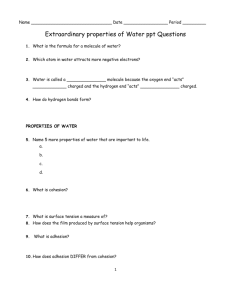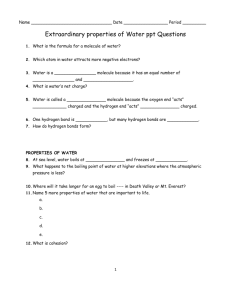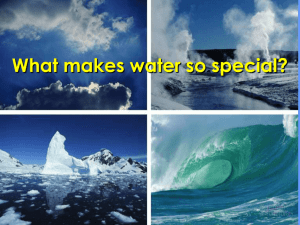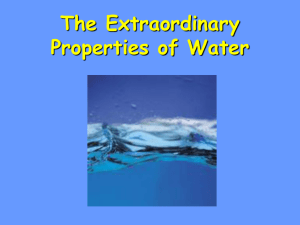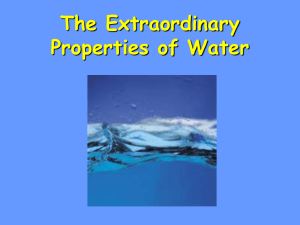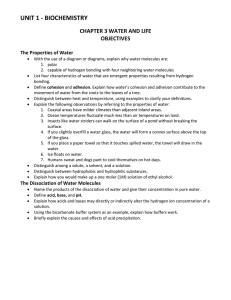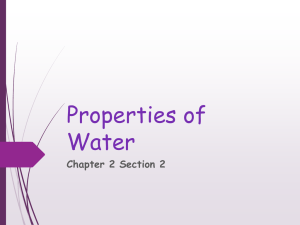Properties of Water
advertisement
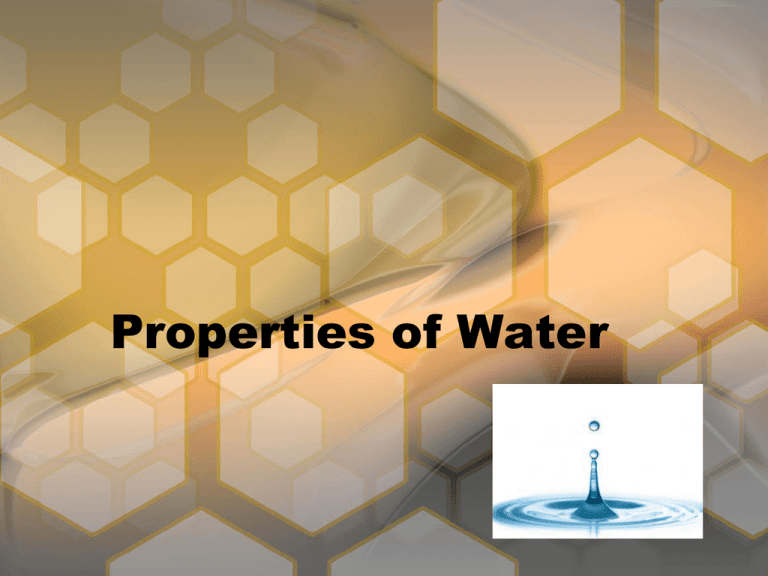
Properties of Water Properties of Water • Objectives: 1. Why are water molecules polar? 2. What are acidic solutions? 3. What are basic solutions? The Water Molecule • Water: – Covers ¾ of the Earth’s surface – Is the most abundant compound in living things – Water is essential for life – Water has unique properties The Water Molecule • Polarity – A water molecule is polar because there is an uneven distribution of electrons between the oxygen and hydrogen atoms. – The average electron density around the oxygen atom in a water molecule is about 10 times that around the hydrogen atoms. Hydrogen Bonds • Polar water molecules act like magnets and attract each other • Hydrogen Bonds – The attraction of the Hydrogen end (+) of one molecule for the Oxygen end (-) of another water molecule. – These are the strongest bonds that can form between molecules • Cohesion is the attraction between molecules of the same substance (water is attracted to water). • Cohesion allows some insects and spiders to walk on water. • The property of the surface of a liquid that allows it to resist an external force is called surface tension Cohesion • Adhesion is the attraction between molecules of different substances • Water is attracted to any substance that has a charge (either + or -) Adhesion Transpiration • Evaporation from the surface of plants. It uses adhesion and cohesion to move water from the roots to the leaves of a plant – Water adheres to the vascular tissue in the roots (adhesion) – Water molecules stick to each other like a chain (cohesion) – Water is moved by evaporation from the leaves Unique Properties of Water • Water is considered the universal solvent • It exists in nature as a solid, liquid or gas • The density of ice is less than liquid water • Water has a high surface tension • Water has a high heat capacity Liquid vs. Ice • Ice is less dense than liquid water. Water is one of the few compounds that is a liquid at the temperatures found over most of Earth’s surfaces. Unlike most other substances, water expands when it freezes. Liquid water is more dense than ice, so ice freezes. Lakes freeze at the top, but fish and other aquatic organisms can survive beneath the surface. Mixtures and Solutions • A mixture is a material composed of two or more compounds that are physically mixed together but not chemically combined. • One type of mixture is a solution. • Solutions are evenly distributed • Two parts of a solution – SOLUTE - Substance that is being dissolved – SOLVENT- Substance into which the solute dissolves Water Solution • Water can dissolve a substance by surrounding it, and forming hydrogen bonds with any +/- charged particles. Water is the Universal Solvent • Water can dissolve almost any substance. • It can do this because of its polarity—it is attracted to any substance that has a charge and will eventually dissolve it. • The only exceptions are substances such as fats and oils that do not have a charge. Acids, Bases & pH • 1 water molecule in 550 million naturally dissociates into a Hydrogen Ion and a Hydroxide Ion H2O Hydrogen Ion Acid H+ + OH - Hydroxide Ion Base The pH Scale • Indicates the concentration of H+ ions • Ranges from 0 – 14 • pH of 7 is neutral • pH 0 – 6.99 is acid … more H+ • pH 7.01 – 14 is basic… less H+ and more OH• Each pH unit represents a factor of 10 times a change in H+ concentration Acids • Any substance that has a higher concentration of H+ ions or releases H+ ions into solution. • Strong Acid = pH 0-3 H+ ions Bases • Any substances that has fewer H+ ions or more OHions. • Strong Base = pH 11 – 14 OH-ions Buffers • Weak acids or bases that react with strong acids or bases to prevent sharp, sudden changes in pH. • Blood contains chemicals that act as buffers to keep blood pH levels healthy.
